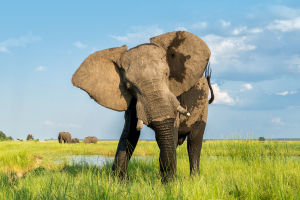The wild tiger is often seen as one of the most majestic yet mysterious creatures of the animal kingdom. Known for their strength, agility, and beauty, tigers have captivated the imagination of humans for centuries.
But beyond their iconic appearance lies a creature facing many challenges to its survival. This article will dive deep into the world of the wild tiger, its unique traits, habitat, and the urgent conservation efforts needed to protect it.
Scientific Classification and Characteristics
The tiger is the largest of the big cats, belonging to the genus Panthera and the species Panthera tigris. Tigers are known for their distinctive orange fur and black stripes, which are unique to each individual, much like human fingerprints. These markings help them blend into their natural environment, aiding in both hunting and camouflage.
There are several subspecies of tigers, including the Siberian tiger, Bengal tiger, Malayan tiger, and Sumatran tiger. While the tiger was once found across large parts of Asia, it is now confined to a smaller range due to habitat loss and poaching. Despite this, the tiger remains a symbol of strength and power, with its imposing figure and unmatched hunting skills.
Behavior and Hunting Skills
Tigers are solitary animals that spend most of their lives alone. They have large territories, which they mark with scent markings to warn other tigers to stay away. These territories can range from 20 to 400 square kilometers, depending on the availability of prey.
As apex predators, tigers are incredibly skilled hunters. They are ambush predators, waiting silently for the perfect moment to strike. Their strength, sharp claws, and powerful jaws make them capable of bringing down prey that is much larger than themselves, such as deer, wild boar, and even buffalo.
Tigers are also strong swimmers, and they often use water to cool off or hunt aquatic prey. Contrary to popular belief, tigers can climb trees as well, although they do so less frequently than other big cats. This ability adds to their versatility in the wild.
Habitat and Geographic Distribution
Tigers once roamed freely across vast areas of Asia, but today they are confined to isolated pockets of their former range. The tiger’s natural habitat includes tropical and subtropical forests, grasslands, and mangrove swamps. The tiger’s range extends across India, Southeast Asia, and parts of China. However, due to increasing human activities such as deforestation and poaching, tigers are now restricted to small, fragmented habitats.
In India, the Bengal tiger remains the most common subspecies, while in Siberia, the Siberian tiger, also known as the Amur tiger, roams the cold forests of the Far East. In other parts of Asia, such as Southeast Asia, the Malayan tiger and Sumatran tiger are found in smaller numbers. Unfortunately, the South China tiger is critically endangered, with very few individuals left in the wild.
Threats to Tiger Populations
The tiger is facing several significant threats in the wild. The most immediate threat to tiger populations is habitat loss. As human populations grow, forests are being cleared for agriculture and development, reducing the tiger’s natural home. Fragmented habitats also make it difficult for tigers to find food, mates, and establish territories.
Poaching is another major threat to tigers. Tigers are hunted for their fur, bones, and other body parts, which are sold on the black market for traditional medicine and luxury items. Despite the ban on tiger hunting, illegal poaching continues to be a significant problem.
Human-wildlife conflict also contributes to the decline in tiger numbers. As human settlements expand into tiger territories, tigers sometimes prey on livestock, leading to retaliation from farmers. This often results in tigers being killed or relocated, further threatening their survival.
Conservation Efforts and Future Outlook
In response to the declining tiger population, various conservation initiatives have been launched worldwide. These efforts include the establishment of protected areas and national parks, anti-poaching laws, and wildlife corridors to connect fragmented habitats. Governments, NGOs, and local communities are working together to create safer environments for tigers.
In India, the Project Tiger initiative, launched in 1973, has played a crucial role in protecting tiger habitats and increasing the population. Similarly, efforts in the Far East, such as the Far East Tiger Program, focus on protecting the Amur tiger from poaching and habitat destruction.
While there is still much work to be done, these conservation programs have shown promising results. The number of tigers in protected areas is slowly increasing, and some regions have even seen the reintroduction of tigers into areas where they had been previously extirpated.
Protecting the Wild Tiger
In conclusion, the wild tiger is an awe-inspiring creature that is essential to the health of the ecosystems it inhabits. However, its future is uncertain, and concerted efforts are needed to ensure its survival. Through continued conservation work, stricter enforcement of anti-poaching laws, and increased awareness, we can help protect this majestic predator for future generations. Let’s work together to safeguard the wild tiger’s place in the natural world and prevent it from disappearing forever.
Dear Lykkers, have you ever had the chance to witness a tiger in the wild? The experience is truly unforgettable! Let’s continue to support efforts that protect these incredible creatures. By doing so, we can ensure the wild tiger will continue to reign as the king of the jungle for generations to come.
Largest Tiger in the World
Video by Aegle Creations


